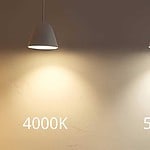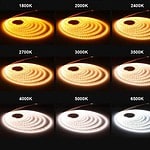Color temperature determines a space’s appearance, ambiance, and functionality. It not only affects our perception of color but also influences our mood and comfort level. This comprehensive guide will discuss the differences between 6000K and 5000K LED lighting.
The main difference between these two color temperatures is their appearance: 6000K LED lights emit a cooler, more blueish-white light, while 5000K LED lights produce a balanced, neutral white light.
These distinct characteristics affect their suitability for various applications, which we will explore to help you choose the best option for your needs.
Understanding Color Temperature and the Kelvin Scale
Definition and measurement of color temperature
Color temperature is a measure that describes the appearance and color of light produced by a light source. It is expressed in degrees Kelvin (K) and is based on the concept of black-body radiation. When a theoretical object called a black body (an ideal emitter and absorber of electromagnetic radiation) is heated, it emits visible light at different wavelengths. As the temperature increases, the color of the light produced shifts from red to yellow, then to white, and finally to blue.
The Kelvin scale is an absolute temperature scale used to define a light source’s color temperature. The scale starts at absolute zero (0 K) and increases as the temperature rises. A lower Kelvin value (around 2700K to 3000K) corresponds to warmer, yellowish-white light, often called “soft white.” As the Kelvin value increases (about 4000K to 5000K), the light appears more neutral and balanced, which is often called “cool white” or “daylight.” At higher Kelvin values (above 6000K), the light appears bluish-white and is often referred to as “cool daylight” or “cool blue.”
The role of color temperature in lighting applications
The role of color temperature in lighting applications is essential for creating the desired atmosphere, enhancing visual comfort, and ensuring optimal performance in various settings. Different color temperatures evoke different emotional responses and affect the functionality of a space. By understanding the significance of color temperature, one can make informed decisions on selecting the appropriate lighting solution for a specific application.
Residential lighting: In homes, the color temperature can significantly impact the ambiance and mood. Warmer color temperatures (2700K to 3000K) are preferred for living rooms, bedrooms, and dining areas, creating a cozy and inviting atmosphere. Cooler color temperatures (4000K to 5000K) are suitable for kitchens, bathrooms, and home offices, where tasks require better visibility and concentration.

Office and commercial lighting: In office spaces, retail stores, and other commercial settings, neutral to cool color temperatures (4000K to 5000K) are commonly used. These color temperatures promote alertness, focus, and productivity, while also rendering colors accurately, which is vital for tasks like reading, writing, or product display.
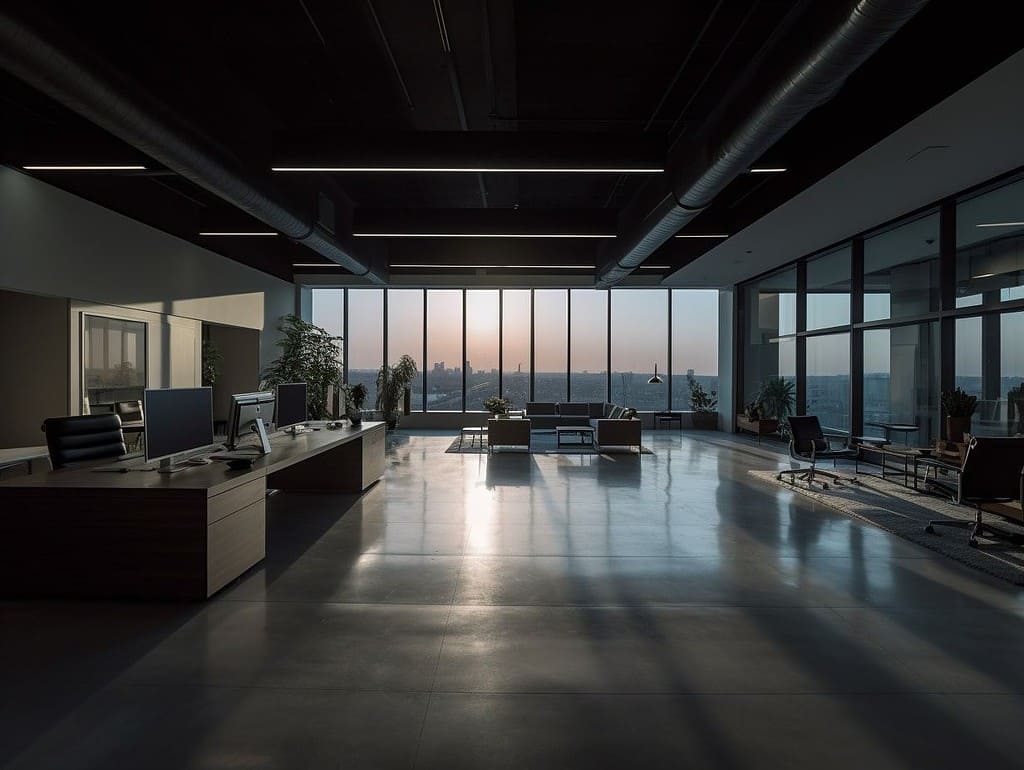
Industrial and outdoor lighting: For industrial applications, warehouses, parking lots, and outdoor areas, higher color temperatures (5000K to 6000K and above) are typically used. The cool white and blue-white light enhances visibility, safety, and security, making it suitable for workspaces and areas requiring high illumination levels.
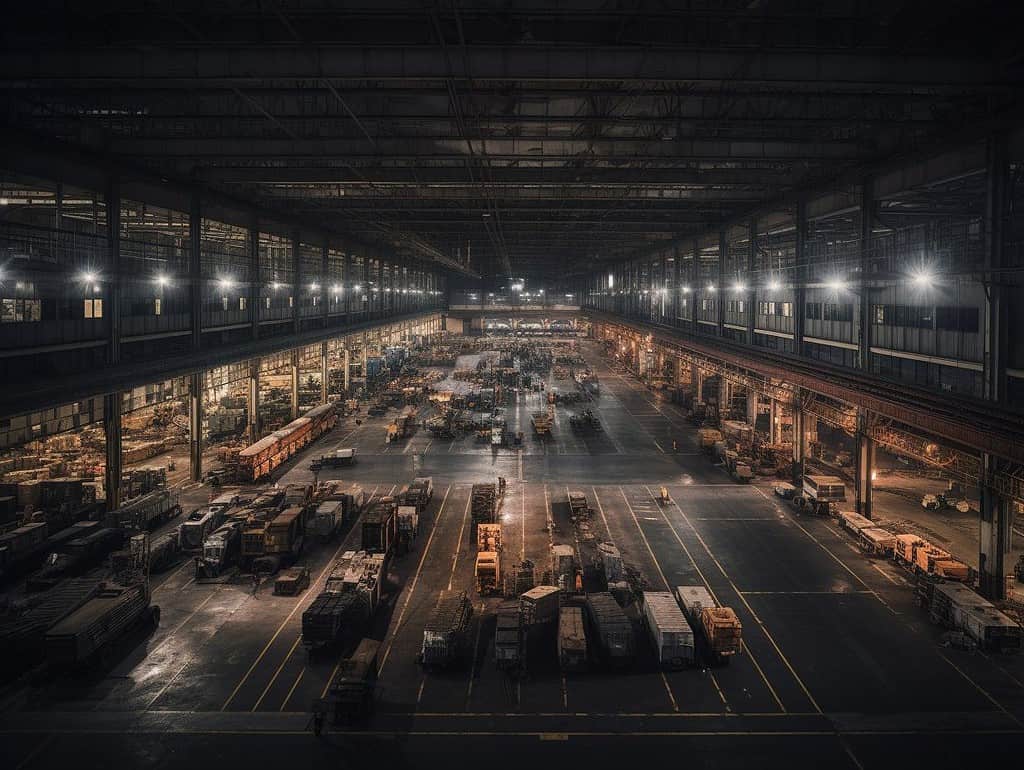
Healthcare and educational facilities: In hospitals, clinics, schools, and universities, color temperature is crucial in creating a comfortable and productive environment. Generally, cool white to daylight color temperatures (4000K to 5000K) are preferred, as they support concentration, reduce eye strain, and provide better visibility.

Art and museum lighting: In art galleries and museums, color temperature is essential for accurately representing colors and enhancing the visual appeal of exhibits. Depending on the artwork or display, various color temperatures may be used, from warm white to cool white, to achieve the desired effect.

In summary, the role of color temperature in lighting applications is to create the appropriate atmosphere, optimize functionality, and ensure visual comfort in various settings. Selecting the right color temperature for a specific application can significantly enhance the overall lighting experience and achieve the desired outcome.
What is 6000K LED lighting?
6000K LED lighting emits a cool white light with a slight blue tint, resembling natural daylight. This color temperature is often associated with clarity, focus, and productivity.
Characteristics of 6000K light
Bright and high-contrast: 6000K light provides a clean and bright environment, making it easier to see details and perform tasks that require attention to detail.
Slightly bluish tint: The cool white light emitted by 6000K LEDs has a subtle blue hue, which can help create a modern and clean aesthetic in various settings.
Enhances visibility and focus: The brightness and color of 6000K light can promote alertness and concentration, making it ideal for spaces where to focus and productivity are essential.
6000K LED light applications
Task lighting: In workspaces, home offices, or garages, 6000K LED lights can provide the optimal level of brightness and visibility for tasks that require precision and attention to detail.

Display lighting: Retail stores and showrooms can benefit from 6000K LED lights to highlight products and create an appealing, attention-grabbing display.
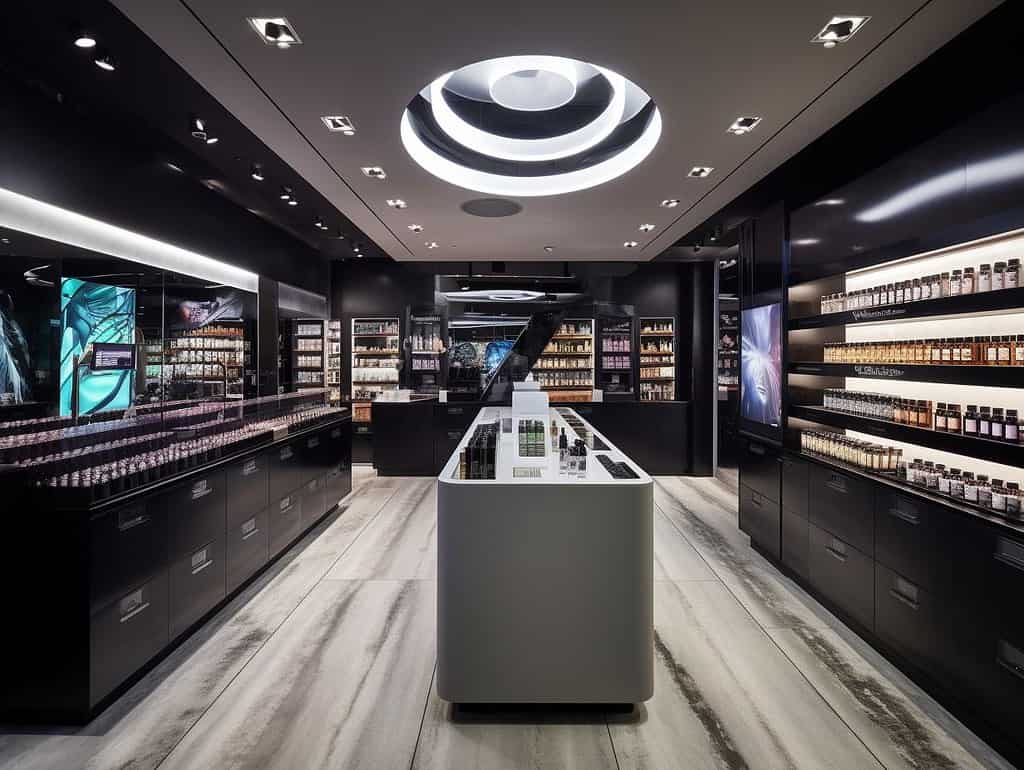
Automotive headlights: Many vehicle headlights use 6000K LEDs for improved visibility, safety, and a modern appearance on the road.
Security lighting: For outdoor areas such as parking lots, building perimeters, and public spaces, 6000K LED lights can enhance security by providing precise and bright illumination, deter potential intruders and help identify suspicious activity.

What is 5000K LED lighting?
5000K LED lighting produces a pure white light, which is softer than 6000K but still bright and clear. This color temperature is often associated with a balanced and comfortable ambiance, making it suitable for various applications.
Characteristics of 5000K light
Pure white light: 5000K LED lights emit a pure, neutral white light, making colors appear more natural and accurate.
Balanced brightness: While still bright, 5000K light is less intense than 6000K, offering a more comfortable illumination level for various settings.
Comfortable and versatile: Due to its neutral tone and balanced brightness, 5000K light is well-suited for various environments and can create a pleasant atmosphere.
5000K LED light applications
General lighting: 5000K LED lights are an excellent choice for general lighting in residential and commercial spaces, providing a comfortable brightness level and a natural color rendition.
Office spaces: In office environments, 5000K LED lights can contribute to a productive, focused atmosphere while minimizing eye strain and fatigue.
Retail stores: The neutral color of 5000K lighting can help display products accurately and attractively, creating an inviting shopping experience for customers.
Outdoor areas: 5000K LED lights can be used in outdoor settings such as parks, gardens, and walkways, providing a well-balanced and inviting illumination that enhances safety and aesthetics.
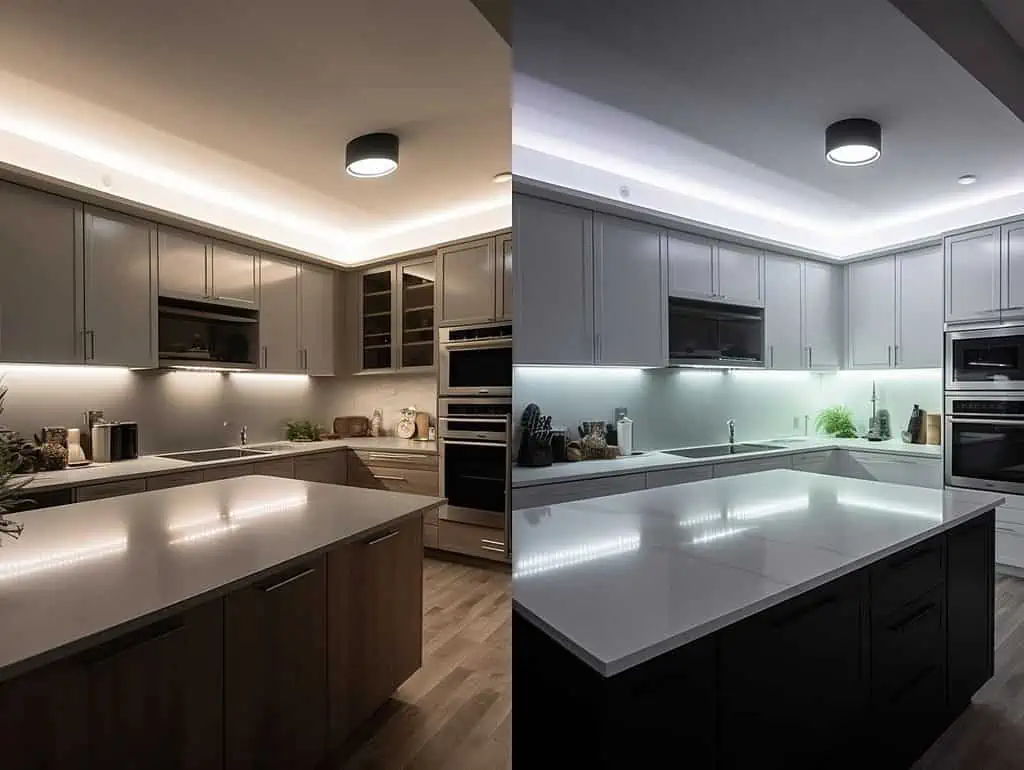
Comparing 6000K and 5000K LED lighting
When comparing 6000K and 5000K LED lighting, understanding the differences between these two color temperatures is essential for choosing your specific needs. While both 6000K and 5000K LED lights are on the cooler end of the color temperature spectrum, they each have distinct characteristics and applications that set them apart. In the following sections, we’ll explore these differences and provide a comprehensive comparison to help you decide which option best fits your lighting requirements. Before diving into the detailed comparison table, let’s first briefly examine the key distinctions between 6000K and 5000K LED lighting.
| Feature | 6000K LED Lighting | 5000K LED Lighting |
| Light color | Cool white with blue tint | Pure white |
| Brightness and lumens | Bright and high contrast | Balanced brightness |
| Under cabinet lighting | Enhanced visibility | Comfortable illumination |
| Task lighting | Better focus | Softer, less harsh light |
| Ambient lighting | Cold and sterile | Balanced and inviting |
| Energy efficiency and watts | Similar | Similar |
6000K vs. 5000K light color
While both 6000K and 5000K are considered cool white lights, 6000K has a more pronounced blue tint, while 5000K emits a pure white light.
Brightness and lumens
6000K lumens: Generally bright and high contrast
5000K lumens: Balanced brightness, comfortable for various applications
Which is brighter: 6000K or 5000K? Both lights have similar brightness levels, with the main difference being their color temperature.
6000K vs. 5000K in various lighting situations
Under cabinet lighting: 5000K provides comfortable and even illumination, while 6000K enhances visibility and contrast.
Task lighting: 6000K is preferred for tasks requiring high levels of focus and attention, while 5000K provides a softer, less harsh light suitable for general tasks.
Ambient lighting: 5000K offers a more balanced and inviting ambiance, while 6000K can create a cold and sterile atmosphere.
Energy efficiency and watts
Both 6000K and 5000K LED lights have similar energy efficiency and wattage requirements. Their primary difference is in their color temperatures and the resulting visual effects.
Comparing 6000K with other color temperatures
6000K vs. 6500K
While both color temperatures are considered cool white, 6500K has a slightly more pronounced blue tint compared to 6000K, making it closer to natural daylight.
6000K vs. 8000K
8000K LED lights emit a much cooler light with a strong blue hue, making them less suitable for general lighting applications and more appropriate for specialized uses, such as aquarium lighting.
6000K vs. 3000K
3000K LED lights produce a warm white light with a yellowish tint, creating a cozy and relaxing atmosphere. In contrast, 6000K offers a cool white light with a blue tint, better suited for task lighting and areas requiring high visibility.
Related Articles
2700K VS 3000K: Which One Do I Need?
3000K vs 4000K: Which Type of Lighting is Good For Home?
Understanding the Differences Between 4000K and 5000K LED Color Temperatures
2700K vs 5000K: What’s the Difference
FAQs
6000K refers to the color temperature of an LED light source, indicating a cool white light with a slightly blue tint.
Lumens measure the brightness of a light source, and 6000K LED lights typically have a high lumen output due to their cool white color. However, the exact lumens depend on the wattage and efficiency of the specific LED light.
6000K LED lights are generally bright and high-contrast, providing enhanced visibility and focus, making them suitable for task lighting and display lighting applications.
Both 6000K and 6500K LED lights have similar brightness levels, with the main difference being their color temperature. The 6500K light has a slightly more pronounced blue tint, resembling natural daylight.
While 6000K lighting can be used in residential settings, it is generally better suited for task, display, and security lighting. Warmer color temperatures (2700K to 3500K) are typically more comfortable and relaxing for living areas and bedrooms.
Yes, the bright and high-contrast nature of 6000K LED lights can improve concentration and productivity, making them an ideal choice for task lighting in office spaces, workshops, and other environments where focus is essential.
5000K LED lights are versatile and suitable for both indoor and outdoor use. They provide a pure white light that is bright but not overly harsh, making them a popular choice for outdoor areas, such as parking lots and streetlights, where visibility is crucial.
Yes, 5000K lighting is a suitable option for photography and videography, as it provides a neutral and balanced white light that closely resembles natural daylight, ensuring accurate color representation and minimizing color distortion.
When deciding between 6000K and 5000K lighting, consider the purpose of the space and the desired ambiance. If you require bright, high-contrast lighting for tasks, displays, or security, 6000K is the better choice. On the other hand, if you’re looking for a more versatile and comfortable lighting option for general use, 5000K is ideal.
Conclusion
6000K LED lights emit a cool white light with a subtle blue tint, while 5000K lights generate a pure white light. Both color temperatures offer similar brightness levels and energy efficiency, making the choice between 6000K and 5000K reliant on the desired ambiance and functionality of the area.
Understanding the distinctions between 6000K and 5000K LED lighting can assist you in determining your lighting requirements. Take into account the color temperature, brightness, and intended use to select the most appropriate LED light for your environment.
LEDYi is a professional Chinese factory that specializes in producing LED strips. If you’re interested in learning more or have any inquiries, feel free to contact us. Our team is ready to help you choose the best LED lighting solution for your needs.


